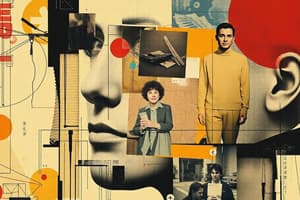Podcast
Questions and Answers
Which theory states that stimulus leads to arousal, and then the experience of emotion?
Which theory states that stimulus leads to arousal, and then the experience of emotion?
- Cannon-Bard theory
- James-Lange theory (correct)
- Two-factor theory
- Spillover effect
What is the essence of the Cannon-Bard theory?
What is the essence of the Cannon-Bard theory?
Physiological arousal and emotional experience occur separately and simultaneously.
What does the Spillover effect describe?
What does the Spillover effect describe?
- Understanding level of physiological arousal (correct)
- Connection between body and mind
- Labeling of emotions
- Different types of emotions
What does the Two-factor theory suggest?
What does the Two-factor theory suggest?
What is unique about the ZaJonc-LeDoux theory?
What is unique about the ZaJonc-LeDoux theory?
What does the Lazarus theory focus on?
What does the Lazarus theory focus on?
Flashcards are hidden until you start studying
Study Notes
James-Lange Theory
- Emotion is experienced after physiological arousal is perceived.
- Example: Increased heart rate and sweating upon encountering a snake leads to the experience of fear.
Cannon-Bard Theory
- Physiological arousal and emotional experience occur simultaneously but are independent.
- Example: Encountering a snake results in heart rate increase and simultaneous experience of fear.
- Criticized for not incorporating the connection between body and mind.
Spillover Effect
- Physical arousal can influence emotional experience based on context.
- Example: Epinephrine injection leads to heightened arousal; knowing this can prevent emotional contagion from others.
- The intensity of arousal remains stable despite changes in emotional direction (e.g., excitement to anger).
Two-Factor Theory
- Emotion arises from cognitive appraisal of physiological arousal.
- Distinct from James-Lange theory; includes labeling the arousal (e.g., identifying feelings as happy or sad).
ZaJonc-LeDoux Theory
- Information processing like a "high road" through the thalamus and cortex allows for complex emotions (e.g., love, hatred).
- Alternatively, the "low road" skips the cortex, sending sensory information directly to the amygdala to evoke basic survival emotions (e.g., fear).
Lazarus Theory
- Cognitive appraisal plays a critical role in distinguishing emotional responses.
- Example: Interpret thoughts about airplane turbulence either to calm oneself or exacerbate anxiety.
- Suggests that cognitive evaluations can happen quickly and unconsciously.
Studying That Suits You
Use AI to generate personalized quizzes and flashcards to suit your learning preferences.




